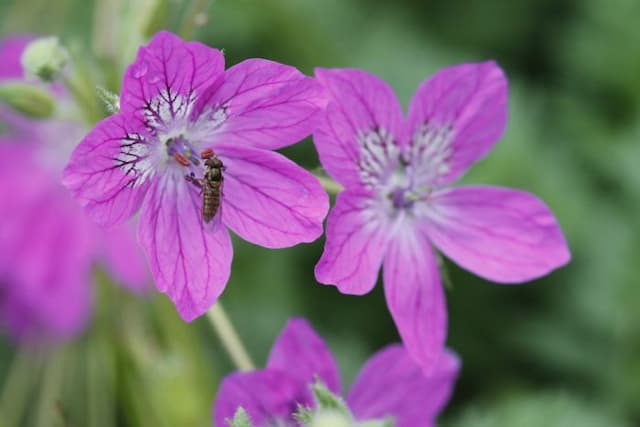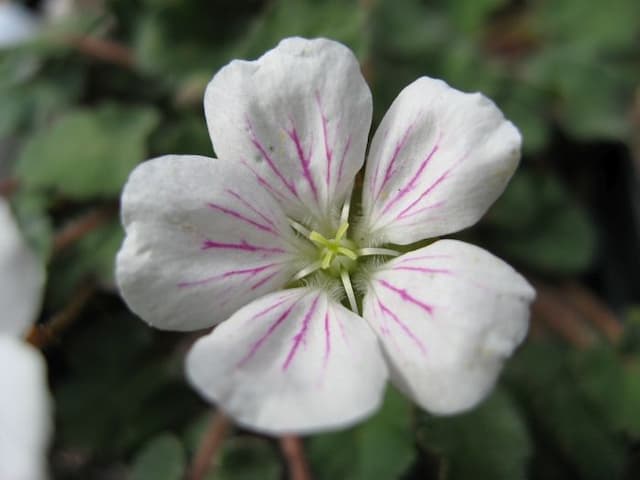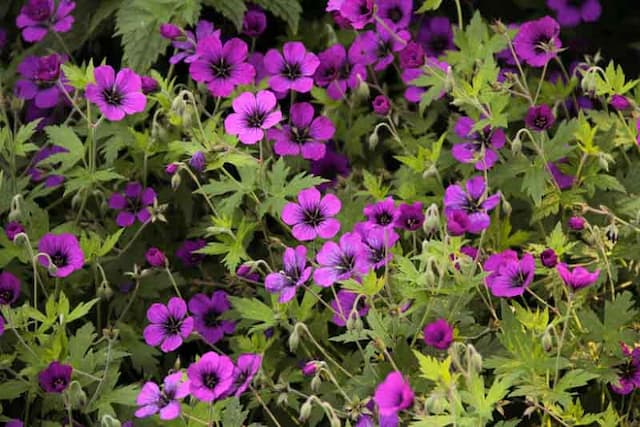Cranesbill Geranium (Cinereum Group) Rothbury Gem = 'Gerfos' (PBR)
![cranesbill [Rothbury Gem]](/_next/image?url=https%3A%2F%2Fplants-admin.emdemapps.com%2Fimages%2Fplants%2F%2Fimages%2F604b6243984c2.png&w=3840&q=75)
ABOUT
Geranium 'Rothbury Gem', commonly known as cranesbill, is a delicate and charming perennial that boasts a low-growing, clump-forming habit. This plant is appreciated for its ornamental qualities, particularly its lovely foliage and attractive flowers. The leaves of the cranesbill are subtly lobed, with a soft green color that provides a lush backdrop to its blooms. These leaves may take on varied tones throughout the seasons, contributing to the plant's visual interest throughout its growth period. The flowers of the 'Rothbury Gem' are truly the stars of the show. They emerge in a striking shade of pale pink, with each bloom featuring five rounded petals that create a classic, simple flower shape. At the center, contrasting veins in a deeper pink hue draw the eye and add depth to the blossom's appearance. The stamens are prominently displayed, with tiny anthers that may be seen upon close observation, adding to the delicate charm of the flowers. Furthermore, the blooms are held aloft on slender stems which rise just above the foliage, creating a floating effect that is visually appealing in garden settings. Without focusing on the size, it is clear that this cranesbill variety presents a lovely and graceful presence that can soften the edges of borders, rock gardens, or serve as an underplanting for taller plants. Its endearing appearance makes it a favorite among gardeners who appreciate subtle beauty and the romantic ambiance these cranesbill flowers can impart to a garden landscape.
About this plant
 Names
NamesFamily
Geraniaceae
Synonyms
Cranesbill, Hardy Geranium
Common names
Geranium cinereum 'Rothbury Gem', Geranium 'Gerfos'.
 Toxicity
ToxicityTo humans
Geraniums, including the 'Rothbury Gem', are generally considered non-toxic to humans. They are commonly used in gardens and as houseplants and there are no significant reports of poisoning from ingestion. However, it is always advisable to avoid eating ornamental plants as they are not intended for human consumption and some individuals may experience gastrointestinal discomfort or mild irritation if any part of the plant is ingested.
To pets
Geraniums, including the 'Rothbury Gem', are generally considered to be of low toxicity to pets. However, ingesting any part of the plant can potentially lead to mild and typically self-limiting gastrointestinal upset in some pets. Symptoms may include vomiting, diarrhea, or loss of appetite. If a pet consumes a significant quantity of the plant, or if you notice any severe reactions, it is important to consult with a veterinarian.
 Characteristics
CharacteristicsLife cycle
Perennials
Foliage type
Semi-deciduous
Color of leaves
Green
Flower color
Pink
Height
0.5 feet (15 cm)
Spread
1 feet (30 cm)
Plant type
Herb
Hardiness zones
5
Native area
Europe
Benefits
 General Benefits
General Benefits- Attractive Flowers - Produces delicate pink flowers with striking veining, enhancing garden aesthetics.
- Compact Growth - Suitable for small gardens or as ground cover due to its low, spreading habit.
- Drought Tolerance - Once established, it can withstand periods of dryness, making it suitable for xeriscaping.
- Low Maintenance - Requires minimal care once established, making it a good choice for low-maintenance gardens.
- Long Blooming Period - Offers a prolonged display of flowers from late spring to early autumn.
- Attracts Pollinators - Invites bees and butterflies, promoting biodiversity in the garden.
- Deer Resistant - Typically unappealing to deer, reducing the risk of damage from wildlife.
- Rock Garden Suitable - Its alpine nature makes it an excellent choice for rock gardens and alpine settings.
- Edging Plant - The neat growth habit makes it ideal for edging paths and borders.
- Container Gardening - Adapts well to container cultivation, perfect for patios and balconies.
 Medical Properties
Medical PropertiesThis plant is not used for medical purposes.
 Air-purifying Qualities
Air-purifying QualitiesThis plant is not specifically known for air purifying qualities.
 Other Uses
Other Uses- Container Planting: Geraniums are often used in pots and containers, bringing color and life to balconies, patios, or windowsills.
- Pressing: The colorful leaves and flowers can be pressed and used in crafts such as card making or decoupage for a decorative touch.
- Edible Decoration: Though not a common practice, geranium petals can be used as edible adornments for salads and desserts.
- Photography Subjects: Gardeners and photographers alike often use geraniums as subjects due to their vibrant colors and intricate patterns.
- Handmade Potpourri: Dried geranium leaves and flowers can contribute to a fragrant potpourri mix.
- Floral Arrangements: Geraniums can be incorporated into bouquets or floral arrangements to provide a splash of color.
- Natural Fabric Dyes: Historically, some geranium species have been used to create natural dyes for fabrics.
- Garden Borders: Geraniums can be planted as border plants in gardens, helping to define areas and paths with their dense foliage.
- Insect-repelling Planting Companions: Some gardeners plant geraniums near other plants to help repel pests, thanks to their strong scent.
- Craft Projects: The sturdy stems and leaves of geraniums can be used in various craft projects, such as making a natural wreath or garland.
Interesting Facts
 Feng Shui
Feng ShuiThe Geranium is not used in Feng Shui practice.
 Zodiac Sign Compitability
Zodiac Sign CompitabilityThe Geranium is not used in astrology practice.
 Plant Symbolism
Plant Symbolism- Unexpected Meeting: Geraniums are often seen as a symbol for an unexpected encounter as their unique beauty can catch the eye of a passerby surprisingly.
- Friendship: They are often given as gifts to represent friendship due to the long-lasting nature of their blooms.
- Good Health: In some cultures, geraniums symbolize a wish for good health, as they were traditionally used in folk medicine and are known to have a pleasant, uplifting scent.
- Positive Emotions: The geranium is sometimes associated with positive feelings such as happiness and joy, perhaps because of its bright and colorful flowers.
- Folly or Stupidity: However, in Victorian flower language, geraniums could sometimes represent foolishness or stupidity, possibly due to their erratic growth patterns.
 Water
WaterThe Hardy Geranium, known as 'Rothbury Gem', should be watered deeply but infrequently to encourage deep root growth. Generally, it should be watered once a week, providing around 1 inch of water each time. During hot, dry periods, you may need to water twice a week. Avoid overhead watering to keep the foliage dry and reduce the risk of diseases. If potted, ensure the pot has good drainage and water when the top inch of soil feels dry to the touch.
 Light
LightThe Hardy Geranium 'Rothbury Gem' thrives in full sun to partial shade. It performs best when it receives at least 4 to 6 hours of sunlight daily. However, in hotter climates, some afternoon shade is beneficial to prevent leaf scorch.
 Temperature
TemperatureHardy Geraniums like 'Rothbury Gem' do well in a wide range of temperatures, growing best between 65°F and 75°F. They can tolerate temperatures down to around 20°F and can withstand occasional frosts but may suffer in prolonged periods of cold. During summer, they can endure temperatures up to 85°F without significant stress.
 Pruning
PruningPrune the Hardy Geranium 'Rothbury Gem' to remove dead or faded flowers and encourage a second flush of blooms. Light pruning can be done throughout the growing season as necessary. The best time for major pruning is in late winter or early spring before new growth begins.
 Cleaning
CleaningAs needed
 Soil
SoilHardy geraniums prefer well-draining soil enriched with organic matter and have a slight preference for neutral to slightly acidic pH levels, ranging from 6.0 to 7.0. A mix of garden soil, compost, and coarse sand or perlite would create an ideal environment for 'Rothbury Gem' geraniums to thrive.
 Repotting
RepottingHardy geraniums like 'Rothbury Gem' generally don't need frequent repotting and can be repotted every 3-4 years or when they outgrow their current container. They are tolerant of being slightly root-bound.
 Humidity & Misting
Humidity & Misting'Rothbury Gem' geraniums are adaptable to a wide range of humidity levels and do well in average garden conditions. They don't require high humidity and are tolerant of dry air, making them suitable for typical outdoor environments.
 Suitable locations
Suitable locationsIndoor
Place in bright, indirect light with good air circulation.
Outdoor
Choose sunny spot; well-drained soil; water when dry.
Hardiness zone
5-8 USDA
 Life cycle
Life cycleThe life cycle of the Geranium (Cinereum Group) 'Rothbury Gem' begins with seed germination, taking place in warm, well-drained soil during spring. Seedlings emerge and grow into young plants, developing a rosette of deeply lobed leaves. As the plant matures, it produces long, slender stems and clusters of delicate, pastel-colored flowers that bloom from late spring to summer. After flowering, the plant sets seed, which can be collected for propagation or allowed to self-seed in the garden. In the fall, the geranium may die back somewhat, but as a perennial, it will regrow from its rootstock the following spring. Throughout its life, 'Rothbury Gem' will periodically require division every few years to maintain vigor and prevent overcrowding.
 Propogation
PropogationPropogation time
Spring to Summer
The Geranium (Cinereum Group) 'Rothbury Gem', commonly known as cranesbill, is most effectively propagated through cuttings. This popular method involves taking a 3-4 inch (approximately 7.5-10 centimeters) stem cutting from a healthy parent plant during the active growing season, typically in late spring or early summer. The cutting should have a few leaves and be snipped just below a leaf node, where the concentration of growth hormones is high. To encourage root growth, the base of the cutting can be dipped in rooting hormone powder before being placed in a pot filled with a well-draining soil mix. The soil should be kept consistently moist but not soggy, and the cutting should be placed in a warm area with filtered sunlight. Roots typically develop within a few weeks, at which point the new cranesbill plant can gradually acclimate to outdoor conditions before being transplanted to its final location in the garden.









